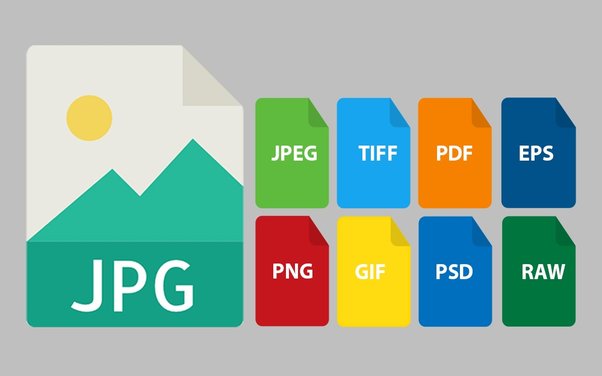Difference Between Jpeg And Png And Tiff File Formats

The main difference between JPEG (Joint Photographic Experts Group) and PNG (Portable Network Graphics) lies in their compression methods and the type of images they are best suited for.
JPEG (Joint Photographic Experts Group) and PNG (Portable Network Graphics) differ in their compression methods and image suitability. JPEG is a lossy compression format ideal for photos and complex images, offering smaller file sizes but sacrificing some quality. PNG is a lossless compression format suitable for graphics, logos, and images requiring transparency, preserving image quality without data loss.
Consider image nature and purpose when choosing between JPEG (smaller size, slight quality loss) and PNG (larger size, high quality).
Comparison of jpeg, png, gif and tiff files
In today’s digital world, understanding the differences between various file formats can be a challenge. If you’ve ever been confused about the difference between jpeg, png and tiff files, you’re not alone. These three file types are used in a variety of ways and each has its own unique benefits. In this article, we’ll explain the differences between jpeg, png and tiff files so you can choose which one is right for your needs.
Have you ever had trouble deciding which image file type to use? You’re not alone! Many people struggle with understanding the differences between jpeg, png and tiff files. These three file types are often used interchangeably but have a few key distinctions that make them ideal for different purposes. We’ll discuss each of these file formats in detail so that you can make an informed decision about what type of image format works best for your needs.
At first glance, it may seem like all three of these image formats are essentially the same thing, but there are some subtle yet important distinctions that set them apart from one another. With this article, we’ll help you understand how jpeg, png and tiff images differ from one another so that you can select the right format for any project or task.
Definition Of Image File Formats
JPEG, PNG and TIFF are all image file formats used to store digital images. JPEG stands for Joint Photographic Experts Group and is a type of lossy compression which reduces the file size of an image by discarding some of the data that makes up the image. PNG stands for Portable Network Graphics and is a lossless compression format, meaning no data is discarded in order to reduce the file size. TIFF stands for Tagged Image File Format and is also a lossless format, though it can also support layers and multiple pages.
JPEGs are best used when you want to save space on your hard drive as they generally have smaller sizes than either TIFF or PNG files, but with a reduction in quality. They’re ideal for web graphics such as website logos or photos that will be posted online. PNGs are great for images that need to retain their original quality or when transparency needs to be preserved, like in logos with transparent backgrounds. TIFFs are usually reserved for high-quality printouts since they don’t lose any information when saved, making them great for editing photos without losing any quality.
All three formats have different advantages depending on what kind of image you’re trying to save or share. Before deciding which one to use, consider what kind of result you want and how much space you need to save on your hard drive or how much detail needs to be preserved in the image.
Comparison of Usage
| File Format | Advantages | Disadvantages | Best Use Case |
|---|---|---|---|
| JPEG | Smaller file size, widely supported, good for photographs | Lossy compression can result in image degradation | Web images, photographs, digital art |
| PNG | Lossless compression, supports transparency, good for graphics | Larger file size compared to JPEG, may not be supported by all web browsers | Logos, graphics, images with transparency |
| TIFF | Lossless compression, high image quality, supports layers and transparency | Large file size, not widely supported by web browsers | Professional photography, print publishing, archiving |
Pros And Cons Of Jpegs
JPEGs are a popular image file format that is widely used for digital images. JPEGs offer great compression, meaning they can be stored in smaller files sizes than other formats like PNG or TIFF. This makes them ideal for web use as they take up less space and can be easily shared over the internet.
However, there are some downsides to using JPEGs. The main disadvantage is that when you compress a JPEG file, it loses some of its detail and quality. This means you may notice a decrease in sharpness or color accuracy when the image is displayed on screen. Additionally, while JPEGs support transparency (the ability to make certain areas of an image transparent), the transparency effect isn’t as smooth as it is with more advanced formats like PNG.
JPEGs are still a great choice for most types of digital images, especially those intended for web use or social media posts. However, if you need an image with high levels of detail and accuracy, or if you need the images to have transparency effects, then another format would be a better choice.
Pros And Cons Of Pngs
PNGs offer some advantages over other file formats. They are great for images with lots of colors, because they support full 24-bit RGB color, as well as grayscale images. The compression ratio is also good, meaning that the image will look clear and won’t be too large in size. Additionally, PNGs support transparency, so you can easily create web graphics with transparent backgrounds or remove backgrounds from photos.
Unfortunately, there are some drawbacks to using PNGs too. For example, they don’t support animation or layers like some other formats do. This means that if you want to create an animated logo or a complex graphic design with several layers, then the PNG format is not ideal for this type of work. Additionally, although the compression ratio is good for most types of images and photos, it can actually make larger files if the image contains fewer colors than it could have.
PNGs are best used for simple images and graphics with lots of colors and smaller file sizes—for example screenshots or logos—as opposed to complex multi-layered graphics or animations. And while PNGs may not always be the perfect choice for every project, they can definitely be a great option when used correctly.
Pros And Cons Of Tiffs
TIFFs are a popular file format for storing images. They offer more options than other file formats, such as JPEG and PNG. The biggest advantage of TIFFs is that they can store high-resolution images without sacrificing quality. They also support multiple layers and image types, making them well suited for graphic design work. However, there are also some drawbacks.
For one thing, TIFFs tend to be much larger files compared to other formats, which can make transfer and storage difficult. Furthermore, because they are not widely supported by many web browsers or applications, you may find it difficult to share your TIFF files with others. Finally, while they support a wide range of color depths and resolutions, they can’t be compressed like JPEG or PNG files, so the sizes remain large regardless of how much detail is included in the image.
In summary, TIFFs have a lot to offer when it comes to editing and storing images at high resolution. However, their large file size makes them difficult to transfer or share with others who don’t have access to the same software or hardware as you do.
Color Depth Comparison
| File Format | Color Depth | Advantages | Disadvantages |
|---|---|---|---|
| JPEG | 24 bit | Smaller file size, widely supported, good for photographs | Lossy compression can result in image degradation |
| PNG | 24-48 bit | Lossless compression, supports transparency, good for graphics | Larger file size compared to JPEG, may not be supported by all web browsers |
| TIFF | 48-64 bit | Lossless compression, high image quality, supports layers and transparency | Large file size, not widely supported by web browsers |
JPEG and PNG are both raster image file formats, meaning they’re made up of pixels. TIFF is a vector image file format, meaning it is made up of lines and curves. When comparing the color depth of these three file formats, there are some key differences to be aware of.
JPEG files can have a maximum color depth of 24 bits per pixel, which means they can contain up to 16 million colors. PNG files have the ability to store more colors than JPEGs, with a maximum color depth of 48 bits per pixel (281 trillion colors). TIFF files also have a much larger range than JPEG or PNG, with a maximum color depth of 64 bits per pixel (18 quintillion colors).
When deciding on which file format to use for an image project, it’s important to consider the type and size of the image you’re working with. For photographic images with many colors, such as landscapes or portraits, JPEGs will usually provide enough detail without taking up too much space.
However, if you need to capture intricate details and subtle gradients in an image then you should opt for either PNG or TIFF as they can store more colors per pixel.
When considering color depth for your images, JPEGs may be suitable for most projects but you may want to use PNG or TIFF depending on what kind of detail you need in your images. Ultimately it depends on what type and size of image you’re working with and how much detail needs to be captured in the final result.
Compression Techniques
Moving on to compression techniques, JPEG and PNG files both use a form of lossy compression.
Lossy compression reduces the file size by discarding information that is not essential or visible to the human eye. This means that while the image size is reduced, some of the quality may be lost in the process.
JPEGs are usually better suited for photographs as they can achieve higher levels of compression without compromising too much on quality. PNGs, on the other hand, are more suitable for line art and simple images with fewer colors as they use lossless compression.
| File Format | Compression | Lossy/Lossless | Transparency | Animation | Alpha Channel |
|---|---|---|---|---|---|
| JPEG | Lossy | Lossy | Not supported | Not supported | Not supported |
| PNG | Lossless | Lossless | Supported | Not supported | Supported |
| TIFF | Lossless | Lossless | Supported | Not supported | Supported |
TIFF files use a form of lossless compression, meaning that no information from the original image is discarded when it is compressed. This means that although TIFF files may take up more space than JPEGs or PNGs, their quality will remain intact regardless of how many times they are saved and opened again. They are also great for editing purposes since any changes made to the file will not compromise its overall quality.
As such, each format offers different advantages depending on what you need it for. JPEGs are best used when you want to reduce the file size and don’t mind losing some of its quality in exchange for smaller file sizes; whereas PNGs offer greater flexibility when creating line art or dealing with transparency; and TIFFs provide an uncompressed option if you want to retain maximum quality in your images but don’t mind having larger files sizes as a result.
Applications For Each File Format
JPEG is the most commonly used image file format as it supports a wide range of applications. It’s particularly suited for web use, due to its relatively small file size and ability to support millions of colors. JPEGs are also suitable for editing, resizing, and compressing without any noticeable loss in quality.
PNG is another popular image file format that offers a higher quality than JPEGs. Its main advantage over JPEGs is that it supports transparency and better color reproduction. PNGs are suitable for web use, but cannot be compressed as much as JPEGs resulting in larger files sizes.
TIFF files are best suited for high-resolution printing or editing since they can store more data than the other two formats. TIFF images are also lossless meaning no information is lost when they’re compressed. However, since TIFF files can be very large, they’re not ideal for web use.
Size Differences Between Formats
When it comes to the size of the file, there are distinct differences between each format. JPEGs tend to be much smaller than PNGs or TIFFs, which makes them great for web use and storage. However, with that reduction in size comes a decrease in image quality. PNGs, on the other hand, provide an excellent balance between quality and size. The files tend to be slightly larger than JPEGs but still small enough for most websites.
TIFF files are usually much larger than JPEGs or PNGs due to their uncompressed nature. This makes them great for printing but not ideal if you need a smaller file size for storage or web uploads. All three formats have their advantages depending on your needs and the purpose of the image.
| File Format | Typical File Size | Compression Ratio | Advantages | Disadvantages |
|---|---|---|---|---|
| JPEG | 100 KB – 10 MB | 10:1 – 30:1 | Small file size, good for photographs | Lossy compression can result in image degradation |
| PNG | 100 KB – 50 MB | 2:1 – 10:1 | Lossless compression, supports transparency, good for graphics | Larger file size compared to JPEG, may not be supported by all web browsers |
| TIFF | 10 MB – 1 GB | 2:1 – 10:1 | Lossless compression, high image quality, supports layers and transparency | Large file size, not widely supported by web browsers |
Interchangeability Among Formats
JPEG, PNG, and TIFF are all different file formats with varying capabilities and uses. It’s important to know that each format is not interchangeable with the other. For instance, a JPEG can’t be converted into a TIFF without losing some of its data. Similarly, a PNG cannot be converted into a JPEG without sacrificing some of its quality.
Each format has advantages and disadvantages depending on what you’re looking for in terms of image quality or file size. For example, JPEGs are widely used in digital photography because they offer a good balance between quality and file size. But if you need the highest possible image quality, then you’ll want to use a TIFF instead since it maintains higher resolution than JPEGs. On the other hand, PNGs provide lossless compression which means that they can retain image detail while still keeping their file sizes small.
So when it comes to interchangeability among formats, it’s important to remember that each one has its own set of strengths and weaknesses. Ultimately, the choice depends on what your goals are for the image you’re working with. The right format will depend on whether you prioritize quality or file size, as well as how much editing capability you need from the image itself.
Exporting Images In Different Formats
To move forward, it’s important to understand the differences between JPEG, PNG, and TIFF file formats. JPEG files are compressed using a lossy compression technique and can contain up to 16 million colors. They’re the most common type of image format and are often used in digital photography or on websites due to their small size. PNG files use a lossless compression technique, meaning no quality is lost when they’re compressed.
However, since they contain 24-bit color information, PNG files tend to be larger than JPEGs. Finally, TIFF files provide high resolution images as they don’t lose any quality during compression. This makes them ideal for high-quality prints, but their large size means that they aren’t typically used for web graphics or digital photography.
When exporting images from an image editing program like Photoshop, there are several options available for different file formats. For example, if you want a high-resolution print of your image you’d likely choose the TIFF format; however, if you wanted a smaller version of your image for web use then you’d select JPEG or PNG. It’s also worth noting that many programs allow users to customize output settings such as resolution or color profile when exporting an image in any file format.
Exporting images in different formats can be useful in a variety of situations depending on the end goal. For example, if you wanted to create a social media post with an image then you’d likely export it as a JPEG or PNG file with low resolution because these formats require less storage space than TIFFs without compromising too much quality. On the other hand, if you were creating prints of your artwork then you should export it as a TIFF with higher resolution since this would result in sharper details when printed out onto paper or canvas.
Frequently Asked Questions
How Do I Know Which File Format To Use For A Particular Project?
Choosing the right file format for a project can be daunting. There are a variety of image formats available, often with overlapping capabilities. It’s important to understand the differences between each format so that you can decide which best suits your needs.
JPEG, PNG and TIFF are three of the most popular formats. JPEGs are ideal for photographs and images with lots of detail, as they’re highly compressed without sacrificing quality. PNGs are great for graphics with text or simple images, as they preserve sharpness and clarity. TIFFs offer multiple layers, making them perfect for archiving your work and creating complex digital artwork.
Each file format has its own advantages and disadvantages, so it’s important to consider what you’ll be using the image for before deciding which one is right for you. For instance, if you’re looking to create a high-quality printout of an image, then a TIFF might be your best choice due to its large size and high resolution capabilities; however, if you’re looking to post an image online or send it via email, then a JPEG or PNG might be more suitable as these formats take up less space on disk and can upload faster than other types of files. Ultimately, it comes down to finding the balance between quality and convenience when selecting which file type will work best for your project.
What Is The Maximum Resolution Offered By Each File Format?
When it comes to deciding which file format to use for a particular project, the maximum resolution offered by each file format is an important factor to consider. JPEG, PNG and TIFF are three popular image formats that offer different levels of resolution and quality. In this article, we’ll explore the maximum resolution offered by each of these file formats and how they can be used in different projects.
JPEG is one of the most commonly used file formats as it offers high-quality images with small file sizes. It also offers maximum resolutions of up to 30 megapixels (MP). This resolution is suitable for most digital media projects such as web pages, emails and social media posts. However, because JPEG uses a lossy compression algorithm, some detail may be lost when images are saved at larger sizes.
PNG is an alternative to JPEG that uses a lossless compression algorithm. This means that there will be no loss of detail when images are saved at high resolutions. PNG offers a maximum resolution of up to 40 MP, making it useful for professional printing projects such as posters or banners. PNG also supports transparency and allows for more vibrant colors than what is available with JPEG files.
TIFF is another image format that provides very good image quality but with much larger file sizes compared to JPEG or PNG. TIFF has a higher maximum resolution than both JPEG and PNG, offering up to 65 MP which makes it ideal for large-format printing projects such as billboards or signage. However, due to its large file size, TIFF files may not be suitable for web or email projects where smaller file sizes are required.
Depending on the project requirements, any one of these three image formats can be used effectively – it just depends on the desired outcome and level of detail needed in the image. When choosing an image format, it’s important to consider the maximum resolution offered by each format in order to get the best possible results from your project.
Are There Any Additional Benefits To Using A Certain File Format?
When it comes to digital images, there are a few different file formats out there. JPEG, PNG, and TIFF are three of the most popular options for storing images. But beyond maximum resolution, are there any additional benefits to using a certain file format?
JPEG files are generally used for photographs and other full-color images. They offer a wide range of resolutions and support most types of image editing. However, because they use lossy compression, JPEGs tend to be lower in quality than the other two formats.
PNG files have become increasingly popular due to their transparency capabilities. They also produce higher-quality images than JPEGs due to their lossless compression. And since they don’t support as much color data as JPEGs, they take up less storage space on your hard drive or online platform.
TIFF files provide the highest resolution possible while keeping the original image quality intact. This makes them great for archiving photos that you don’t want to edit later on down the line. Additionally, many professional photographers prefer TIFF files because they maintain the original image data without compression artifacts showing up in prints or screen displays.
Whether you’re looking for a high-resolution image archive or an easily editable photograph file format, each of these three options can provide what you need with its own set of advantages and disadvantages. Understanding which one works best for your project is key to getting the desired results from your digital images.
What Is The Best Way To Optimize Images For Web Use?
Optimizing images for web use is a critical step in creating a successful website. Whether the goal is to promote a business or just showcase your work, the right image format can make all the difference. In this article, we’ll explore the best way to optimize images for web use.
When it comes to selecting an image format for web use, JPEGs and PNGs are two of the most widely used options. JPEGs offer high quality while maintaining a relatively small file size, making them well-suited for photos and other detailed images. PNGs are lossless and can be used for logos and graphics that require transparency.
The key to optimizing an image lies in finding the right balance between file size and image quality. For example, you may need to reduce the resolution of an image in order to reduce its file size, but doing so will also reduce its overall quality. Similarly, increasing an image’s dimensions will increase its quality but also its file size. Understanding how these elements interact is essential for producing optimized images suitable for web use.
Fortunately, there are tools available that can help you achieve optimal results with minimal effort. Image compression software can automatically adjust resolution and dimensions without compromising too much on quality; many even come with presets specifically designed for web use that you can apply with just one click!
Is There A Way To Batch Convert Images From One File Format To Another?
Is there a way to batch convert images from one file format to another? This is a question that many people ask when they are working with web images. Whether you are optimizing photos for the web or just trying to save time by converting multiple images at once, there are ways to accomplish this task.
One of the most popular options for batch image conversion is an online converter. These services allow you to upload multiple images and then choose what type of output you want. In addition, many online converters can also resize and compress your images so they will be suitable for web use. For example, if you want to convert several JPEGs into PNGs, an online converter could easily do this in one go.
Another option is to use a piece of software specifically designed for image conversion. There are many programs available that can help automate the process of converting images from one format to another. Some of these programs even include other features such as resizing and compression, making them ideal for web optimization purposes. Plus, some software products even include additional tools like watermarking and image editing capabilities, giving you even more control over how your images look on the web.
No matter which method you choose for batch image conversion, it’s important to make sure that the output files are optimized correctly so they load quickly on websites and look great on any device or browser. By taking a few extra steps ahead of time, you can save yourself time and energy in the long run when it comes to managing your digital assets.
Conclusion
In conclusion, it can be difficult to decide which file format is best for a particular project. JPEG, PNG and TIFF all offer different advantages, depending on the resolution required and the intended use of the image. It’s important to consider how an image will be viewed on the web when choosing a file format as this can affect how quickly a website loads.
Optimizing images for web use is also beneficial in improving performance and user experience. Finally, batch converting images from one file format to another can help save time if multiple images need to be converted quickly.
In short, it’s important to understand each file format’s capabilities and potential uses in order to choose the right one for your project. As long as you take these factors into account, you should have no problem finding the perfect fit for your needs.








